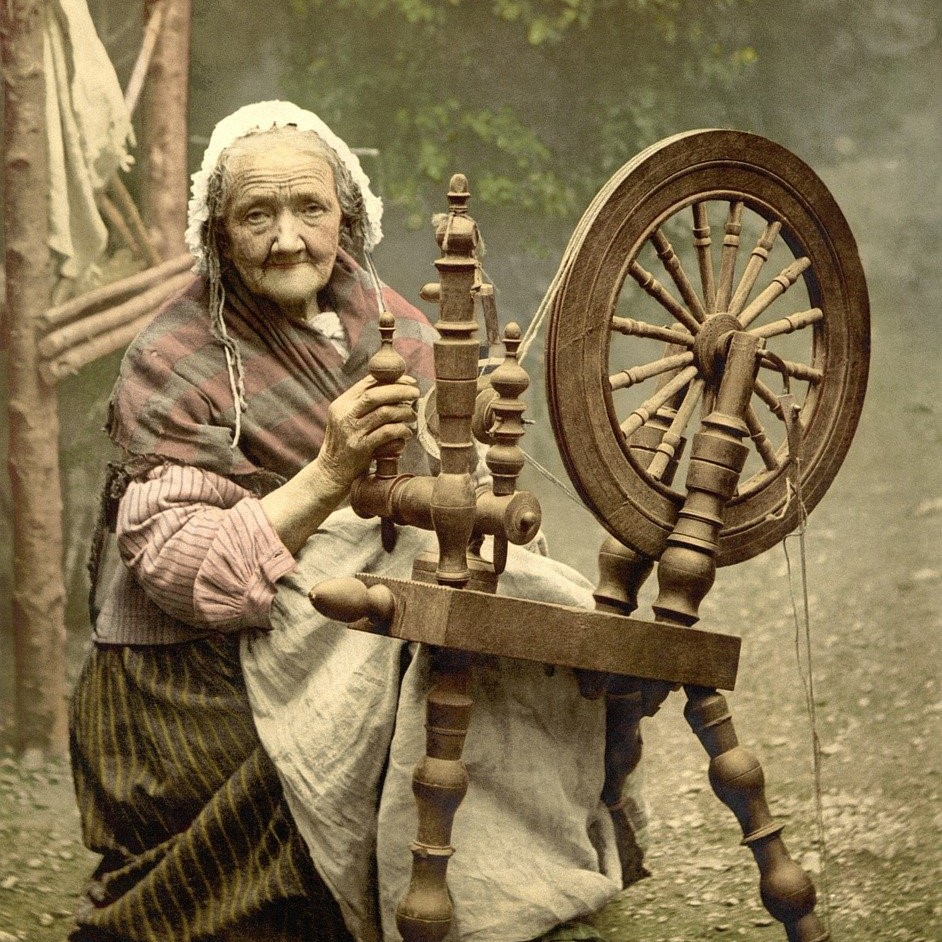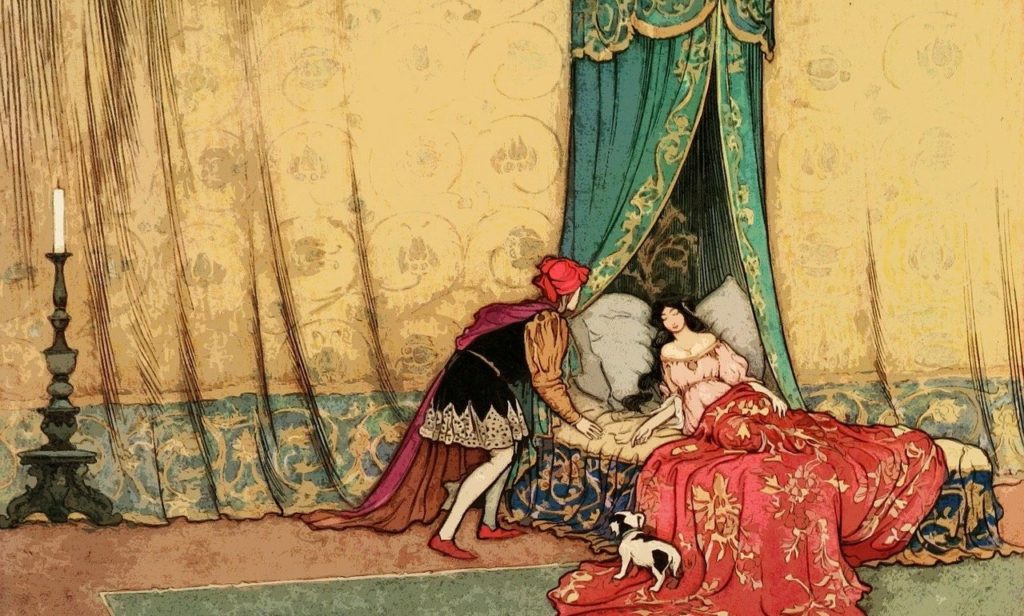I think I speak for adults everywhere when I say that I don’t get enough sleep. Aside from being a busy person, I’ve had recurrent insomnia since I was eight years old, and I’m a proud night owl. This means that my best writing happens between 9:00 pm and 3:00 am, which does absolutely nothing for my already terrible sleeping genes.
Coming from that context, I really don’t think a 100-year sleeping curse sounds that bad. Especially if all your loved ones are snoozing alongside you and everybody stays young, why not embrace a little beauty sleep? Still though, the concept of a ravishing princess frozen in time in her castle is such a captivating portrait that I understand why her story is so timeless IRL.
I’m a HUGE fan of Sleeping Beauty, both the fairy tale and the movie adaptation that’s oh so familiar. This story makes my top ten list of fairy tales, but you might not know . . . the original Sleeping Beauty is dark. And extremely icky in every sense of the word.
For Once, the Grimms’ Version Ain’t So Bad
“Little Brier-Rose” may be darker than Disney, but it’s among the tamest of the Grimms’ collection and heavily inspired the movie. We all know how it starts: a king and queen throw a grand birthday party for their long-awaited princess. And one slighted fairy gets left off the guest list.

Here there are twelve good fairies and one unlucky number thirteen. She realizes the royals’ insult because there are only twelve golden place settings for the fairies, and she proceeds to curse the little princess to prick her finger on a spindle and die at age fifteen. Harsh, ma’am. Harsh.
But one good fairy softens the blow by changing the death sentence to one hundred years of sleep. The king and queen still burn all the spinning wheels to escape the prophecy, but somehow a random spinster woman in a remote tower doesn’t hear the royal decree and continues to use a spindle. For the record, this woman has no ill intentions toward the princess, but Brier-Rose does find her. When the princess touches the spindle out of curiosity, she immediately collapses into her century-long sleep.
The Rest is Basically the Disney Movie
The original good fairy puts the entire court and Brier-Rose’s family to sleep and grows a wall of vicious thorns to protect the princess in her slumber. Of course the Grimms include the gnarly detail that several princes try to rescue her and are graphically impaled to death on the thorns. What’s a Grimm fairy tale without some bloodshed?

But eventually Prince Charming arrives after one hundred years, and the thorny barrier parts for him to find Brier-Rose. He’s enraptured with her beauty and kisses her just moments before she awakes. Take note that the prince’s kiss doesn’t actually break the curse in the original Sleeping Beauty. He just happens to show up right on time and kiss her when the century-long time-ticker runs out. Super convenient, but it is a fairy tale. Give it a break.
The Grimm Brothers very nearly cut Little Brier-Rose from their fairy tale collection because it was just too French for them. Truthfully, they borrowed most of their material from the unabridged version by Charles Perrault.
The French Sleeping Beauty Had a Longer Road to Travel
Charles Perrault’s “The Sleeping Beauty in the Wood” was published years before the Grimms’ tale and has some pretty distinct differences. Here we have seven good fairies at the baby’s celebration, and the king and queen didn’t invite the eighth only because they thought the old sprite was dead! Plausible explanation. But not a good enough one for the wicked fairy. There aren’t enough golden dishes for her place setting, so she curses that baby.

Perrault leaves out any gruesome details about princes dying in the thorns, and here the prince also avoids any nonconsensual kissing by arriving just in the time to see the princess awake. There’s some lovely details about them talking for hours while the entire court awakes in the palace, so they do kind of get to know each other before tying the knot that very day.
And getting—ahem—very little sleep afterwards. Charles, you scallywag.
But Perrault’s Version Doesn’t End There!
The French Sleeping Beauty and her prince have two children together named Morning and Day, and the prince travels back and forth between his kingdom and Beauty’s for years in an effort to keep his marriage a secret from his mother. Apparently the woman is descended from ogres and has “ogreish inclinations.” Meaning she eats children. This is not even close to the first fairy tale villain to partake in cannibalism.
The prince waits until he becomes king to bring Beauty, Morning, and Day to his kingdom. Of course the second the new king leaves to fight in a war, the ogress queen mother makes her move to eat Morning, Day, and Sleeping Beauty herself. Thanks to a kind cook, the ogress eats two lambs and a hind instead while his wife shelters the royal family.
The second Mommy Dearest discovers that she’s been deceived, she drags out the whole family to throw them in a tub of toads and serpents. But before all is lost, the king FINALLY shows up. Her plot foiled, Mom flies into a rage, throws herself into the tub of nasties, and dies. Everyone else lives happily ever after.

So . . . Is Perrault the Original Sleeping Beauty?
Believe it or not, there’s an even earlier rendition of this story with most of the same plot points as Perrault and even more disturbing details: “Sun, Moon, and Talia” by Giambattista Basile.
This weird Italian Sleeping Beauty was published in 1634, more than sixty years before Perrault’s rendition. Here Sleeping Beauty is named Talia, and astrologers predict at her birth that a tiny splinter of flax will be her undoing. The king banishes all flax, hemp, and other spinning materials from the kingdom, but a passing peddler woman spinning flax catches Talia’s attention. When the princess tries to spin, a splinter of flax wedges itself under her nail. She promptly drops dead.
The distraught king lays her beautiful body in a country manor and abandons the house forever. Years pass before a king from a neighboring land is hunting in the woods and finds Talia. Struck by her beauty, he tries to wake her. When that fails, he rapes her and returns home.
Yeah. The guy literally rapes a woman’s corpse before heading out on his merry way.

But Wait! It Gets Weirder
Nine months later, Talia gives birth to twins—Sun and Moon—and some fairies place the babies on her breast to suckle. When one of the babies sucks the flax splinter out of her finger, Talia awakes from death! She’s confused but happy to see her gorgeous babies for the first time.
Talia and company chill out in the manor until the king who impregnated her returns. Mr. Rapist is overjoyed to discover his new family and tells Talia about what he did. Instead of her running away screaming, “their friendship was knitted with tighter bonds.” Okay then, Basile.
The king stays with Talia for a time before returning home—TO HIS WIFE! You read that right: the sneaky rapist is married. And there’s zero textual evidence that Talia knows this little detail.
But the Jilted Wife Becomes Basile’s Villain
His wife suspects that her husband is having an affair out in the woods instead of hunting as he claims. When she finds out about Talia, she sends a messenger on the sly to have the children brought to their sire the king. Talia, who has no clue what’s going on, happily sends the kids to visit Dad. The queen orders the cook to roast the children up and serve them as dinner to their father. Thankfully the cook and his wife hide the kids and serve the king lamb instead.
Next the queen sends for Talia and accuses her of man stealing. When Talia explains that um—the guy raped me in my sleep and I didn’t know he was married, the queen won’t listen. When she commands Talia to be thrown into a fire, Talia stalls for time by offering to take off her clothes (can’t make this stuff up, people). The greedy queen agrees since she wants Talia’s fine jewel-encrusted garments. So Talia strips piece by piece, making a big show of screaming until the king finally arrives on scene.
When he demands what is going on, the queen announces that she fed him his bastard children. In a rage, the king throws his wife and all her accomplices into the fire they made up for Talia. Before the cook can be burned, he produces Sun and Moon, who he saved. Everyone rejoices that the children are alive, and the king marries Talia.
So . . . What’s the Moral of the Original Sleeping Beauty?
Those whom fortune favors
Sun, Moon, and Talia, Giambattista Basile
Find good luck even in their sleep.
Seriously, THAT’S the message Basile is presenting from all that debauchery. Granted, you have to admit that Talia getting crowned a queen and raising beautiful heirs is a pretty sweet deal for a girl who dropped over dead.
But marrying your rapist? Not so great. Unfortunately in the seventeenth century, such endings happened to women all the time to smooth over out-of-wedlock pregnancies. And the girls were considered lucky to get that outcome. Even the king’s infidelity to his current wife is ignored in the original Sleeping Beauty. I guess Basile thought that a woman evil enough to cook up her husbands’ bastards obviously deserves what she gets, right? Ugh.
As if all that isn’t bad enough, this story also has some strong necrophilia undertones. The Grimms and Perrault specify that Sleeping Beauty is asleep, but Basile calls her dead. Which adds another level of ick to that rape scene . . . but let’s not dwell on THAT a moment longer than we have to.

Thankfully the Original Sleeping Beauty Got Sanitized
The modern versions of this tale are way easier to stomach, but this is still far from a girl power story. Talia, Brier-Rose, and even Disney’s Aurora basically do nothing over the course of the story besides sleep beautifully and react to what’s happening around them. Aurora doesn’t even get the active moment of showing interest in the spinning wheel. Disney put her in a magical trance for that scene, so she’s basically unconscious for the rest of the movie.
At this point, you might be asking why I love this story so much if its roots are so icky and even the Disney film features a passive heroine. Despite the horror of the original Sleeping Beauty, there are some genuinely wonderful themes that crop up in this story.
At Its Heart, Sleeping Beauty Is About Growing Up
There’s a pronounced sense of dread in this tale surrounding the princess meeting her fate and having her blood drawn by the spindle. Some theorists believe that part of the story is symbolic of menstruation: Aurora becoming a woman and losing control of her life as she waits to be ushered into wedded bliss.
This is a fascinating interpretation of Sleeping Beauty, and frankly one I can relate to. I’ve experienced the frustration of waiting for a man in a marriage-obsessed culture. Patience is not my favorite virtue, but I also appreciate how this is a story filled with love. The entire cast—evil fairy notwithstanding—comes together to fight for Aurora. To rally around her and make sure that she has the gifts, protection, magical loopholes, and support to make it. I feel like that’s a highly underappreciated aspect of growing up: all the people willing to lend a helping hand to help women reach their potential, whatever the cultural definition.
It’s really no wonder why Sleeping Beauty is still a favorite fairy tale. How could it not be with its ultimate message of romance and hope?

Fate, Fairies, and Forgiveness
I’m also a huge fan of characters trying to escape their fate. And the measures they take that somehow make that fate come true anyway. Think about it: if the king hadn’t burned those spinning wheels, Brier-Rose wouldn’t have found that fateful spindle so fascinating. One way or another, Sleeping Beauty always, always falls into the curse, no matter how hard her parents try to prevent it.
The girl could just be extremely unlucky—except that each story ends up WAY better than it could have. The whole curse business with the fairies is such a great hook. We’re all waiting for the shoe to drop as the princess blossoms. And despite the parents’ mistake, there’s still a fairy godmother in shining armor to rescue their beloved daughter.
I personally believe that the happy ending despite the peril is what makes this story so lovely. Sleeping Beauty and her parents didn’t truly deserve their curse, but going through it still wins them a good outcome. And all the twists and darkness and waiting makes the ending all the sweeter when it arrives. It’s the happily ever after trope at its finest. ❧




